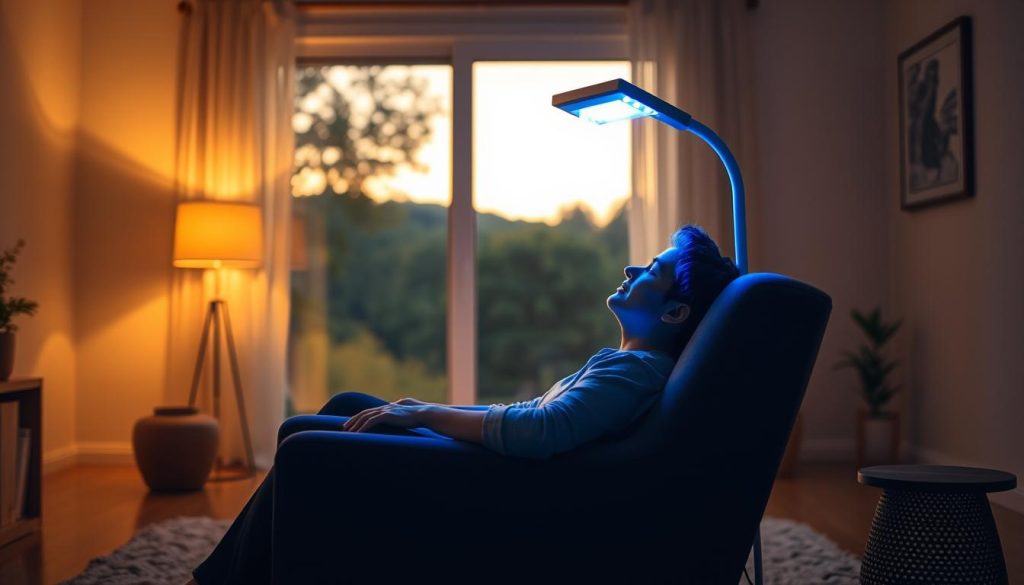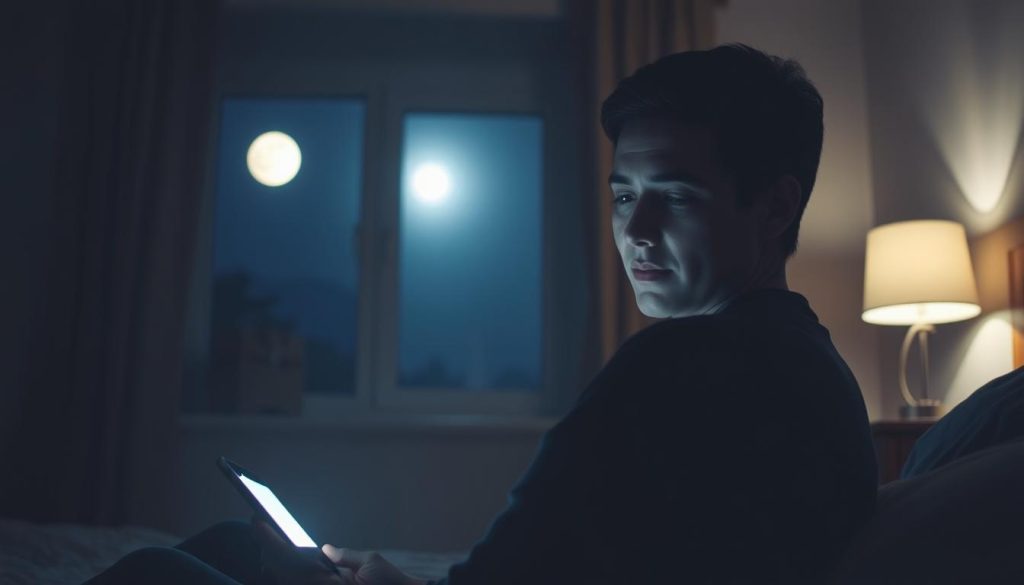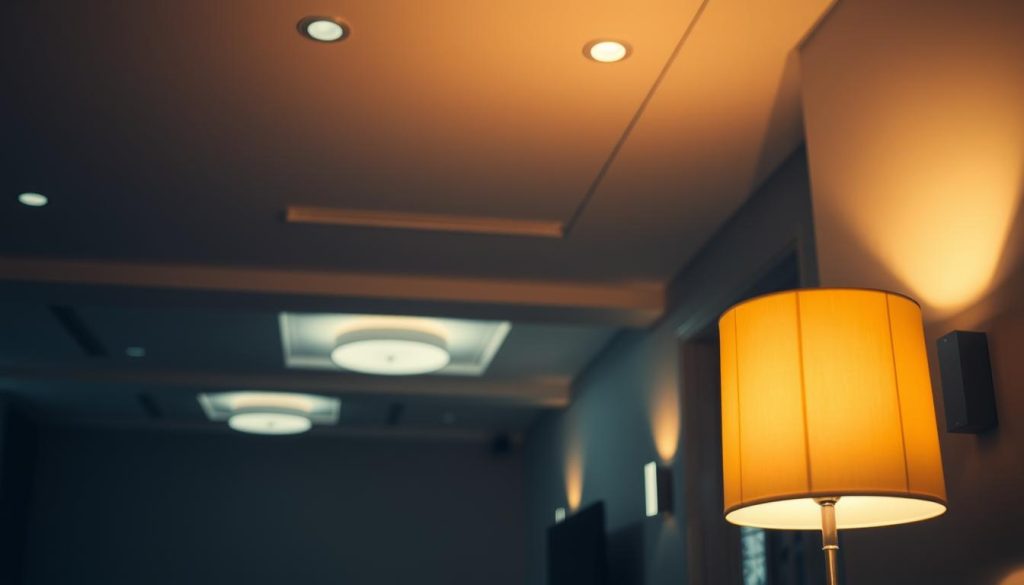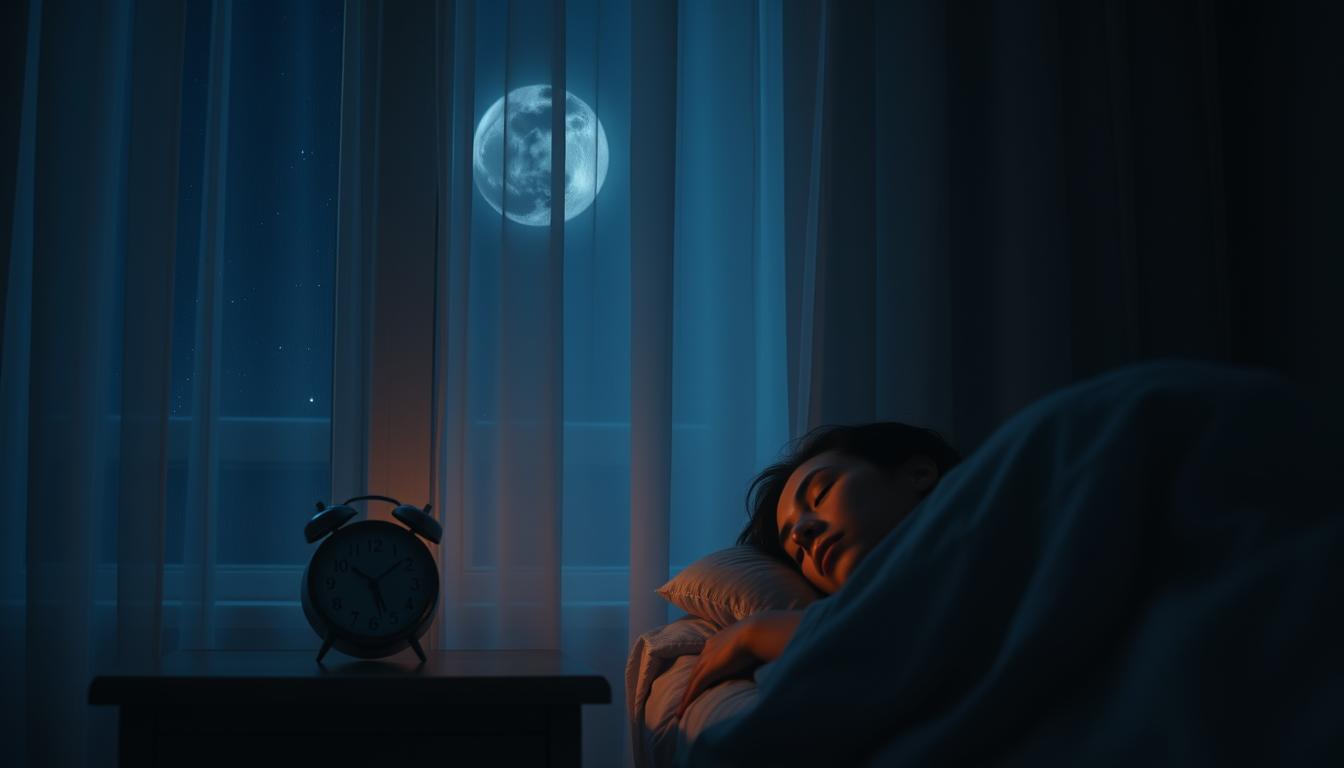Light and our circadian rhythm are closely linked to our health. Our internal clocks, or circadian rhythms, adjust based on the light we get. This affects our sleep, mood, and many other biological processes.
Both natural and artificial light shape our daily lives. Understanding the role of light in health and how to manage our circadian rhythm is key. We’ll look into how light affects our biological clock and the benefits of balanced light exposure.
Understanding Circadian Rhythms
Circadian rhythms are at the core of our daily lives. They control our body’s functions, especially through the biological clock. This system keeps us in sync with the day-night cycle.
The Biological Clock
The biological clock is in the brain’s SCN. It manages our sleep, hormone levels, and other functions. Our DNA guides these rhythms. The clock adjusts to light and temperature to keep our body in rhythm.
Key Functions of Circadian Rhythms
Circadian rhythms are vital for our sleep, hormone release, and body temperature. They tell us when to be awake or sleep. They also control our hormone levels, eating, and metabolism, helping our health.
The Role of Light in Regulating Circadian Rhythms
Lighting is key to syncing our body clocks with the 24-hour day. This process, called circadian entrainment, is vital for our health and happiness.
Light as a Zeitgeber
Light is a powerful cue for our body clocks, acting as a “time giver.” Morning natural light helps reset our clocks, making us function better all day. The intensity and timing of light matter, with morning light best for advancing our rhythms.
Types of Light and Their Effects
Not all light affects us the same way. Natural sunlight and artificial light have different effects on our body clocks. Blue light from screens and LEDs is especially strong in shaping our rhythms.
Blue light can lower melatonin, the sleep hormone. Natural sunlight, with its balanced spectrum, positively affects our clocks. It’s important to manage light intensity and timing for better health and performance.
| Type of Light | Common Sources | Effects on Circadian Rhythms |
|---|---|---|
| Natural Sunlight | Sun, Skylights | Facilitates circadian entrainment; promotes wakefulness and vitality during the day. |
| Blue Light | LED Screens, Electronics | Suppresses melatonin, potentially disrupting sleep patterns if exposed to at night. |
Natural Light Exposure Benefits
Getting natural light can make you healthier and happier. This part talks about how it boosts mood, energy, and vitamin D levels.
Mood and Energy Levels
Natural light is good for everyone, making you feel better and more energetic. Research shows it helps fight depression and anxiety. It also makes you more productive and social.
Vitamin D Synthesis
One big plus of natural light is it helps make vitamin D in your skin. Vitamin D is key for strong bones, a healthy immune system, and preventing diseases. Being outside in the sun helps your body make enough vitamin D, keeping you healthy and full of energy.
Effects of Artificial Light on Circadian Rhythms
Artificial light is changing how we live, especially with more devices that light up. Light from screens, like phones and computers, after dark messes with our sleep cycle. This can make it hard to fall asleep and stay asleep all night.
Our body has a natural clock that tells us when to sleep and wake. But, blue light from screens in the evening tricks our brain. It’s important to limit screen time to keep our natural rhythm and avoid sleep problems.
Here’s a table showing the difference between natural and artificial light:
| Natural Light | Artificial Light |
|---|---|
| Boosts mood and energy | Disrupts circadian rhythms |
| Promotes Vitamin D synthesis | Linked to sleep disorders |
| Balances internal body clock | Increases blue light exposure |
In short, artificial light is a big part of our lives today. But, we need to control its effect on our body’s clock to sleep well and stay healthy.
How to Optimize Light Exposure for Better Sleep
To get better sleep, it’s key to know how light affects our body clocks. By adjusting light exposure, we can boost our health and happiness. We’ll look at how to use morning sunlight and reduce blue light at night.
Morning Light Exposure
Starting your day with sunlight is a smart move. It tells your body it’s time to wake up and be ready. Try to spend 20-30 minutes outside right after waking up.
This morning sunlight boosts your mood, energy, and alertness all day long.
Avoiding Blue Light at Night
But, blue light from screens and lights at night can mess with your sleep. It’s important to use blue light filters or dim, warm lights as bedtime nears. Also, having a calm evening routine without screens can help you sleep better.
Circadian Rhythm Light Therapy Uses
Circadian rhythm light therapy helps people with disorders related to their internal clocks. It’s great for those with Seasonal Affective Disorder (SAD) and shift work sleep disorder. This therapy works by regulating melatonin, helping the body’s clock stay in sync.

Applications for Seasonal Affective Disorder
Seasonal Affective Disorder (SAD) happens in fall and winter when it’s dark. Light therapy mimics sunlight, boosting serotonin and mood. People feel more awake and less sad after using it.
Benefits for Shift Workers
Shift work sleep disorder affects those with odd work hours. It messes with sleep and internal clocks. Light therapy helps shift workers by adjusting their clocks, reducing tiredness, and improving sleep.
The Importance of Light Exposure for Health
Light is key for keeping our bodies and minds healthy. It helps our internal clock stay in sync with day and night. This boosts our overall health.
Daylight helps control melatonin, which is vital for sleep. Good sleep supports our bodies and minds. It also lowers the chance of getting sick.
Natural and artificial light can help us feel better. Natural light lifts our mood and energy. Artificial light, like avoiding blue light at night, helps us sleep better.
Knowing how light affects us can greatly benefit our health. Doctors use light therapy for conditions like SAD and to help shift workers sleep better.
| Aspect | Impact of Light Exposure |
|---|---|
| Physical Health | Enhances immune function, improves sleep quality, stimulates Vitamin D synthesis |
| Mental Health | Reduces depression and anxiety, enhances mood and cognitive function |
| Well-being | Maintains circadian rhythms, boosts overall mood and energy |
In summary, focusing on light is crucial for our health. Using light in our daily lives improves sleep, mood, and overall well-being. As we live in today’s world, understanding and using light is key to staying healthy.
Strategies for Regulating Circadian Rhythm with Light
Getting the right amount of light is key to a good circadian rhythm. By using certain strategies, you can sleep better and feel healthier. We’ll explore how to keep a steady light-dark cycle and create the perfect lighting for your space.
Consistent Light-Dark Cycles
Keeping a regular light-dark cycle is a top strategy. Your body loves routine. So, wake up to bright, natural light in the morning. It helps you feel alert and awake.
As night falls, cut down on artificial light, especially blue light from screens. It tells your body it’s time to relax. Blackout curtains can also help block outside light while you sleep.
Adjusting Light Environments
Customizing your lighting can also help your circadian rhythm. Adjusting lights at home and work can sync with your natural rhythm. Think about using dimmable lights and smart bulbs that change color and brightness.
Using natural light and warm lighting in the evening can set the mood for rest. Here’s a guide on when to use different types of light:
| Type of Light | Recommended Usage Time | Effect on Circadian Rhythm |
|---|---|---|
| Natural Sunlight | Morning to Early Afternoon | Boosts alertness and mood |
| Cool White Light | Morning to Late Afternoon | Increases focus and productivity |
| Warm Light | Evening | Promotes relaxation and prepares for sleep |
By following these tips, like keeping a steady light-dark cycle and customizing your lighting, you can improve your sleep and health.
Light Exposure and Melatonin Production
It’s important to understand how light affects melatonin production for better sleep. Melatonin, or the sleep hormone, changes with light. It goes up in the dark and down in the light.
How Light Affects Melatonin Levels
Light, especially blue light, can change melatonin levels a lot. During the day, light helps control hormone levels and keeps our body clock in sync. But, bright lights in the evening can push back melatonin production, messing with our sleep.
Timing of Light Exposure
When we get light is key for melatonin production. Morning light helps set our internal clock right with nature. But, too much light in the evening, especially from screens, stops melatonin from coming out. This makes it hard to fall asleep.

Impacts of Reduced Natural Light Exposure
Less natural light can harm our health, affecting both body and mind. It can lead to depression. Not getting enough sunlight can make us feel sad or hopeless. This is especially true in winter when days are shorter.
Eye strain is another issue with less natural light. Being indoors too long can make our eyes tired. Natural light is easier on our eyes than artificial light.
Not getting enough sunlight can also hurt our health in other ways. It can mess up our sleep patterns. This affects our body’s functions, like how we metabolize food and fight off infections.
To understand the difference between natural and artificial light, look at this:
| Natural Light Exposure | Artificial Light Exposure |
|---|---|
| Boosts mood and decreases depression | Increases risk of depression |
| Reduces eye strain | Can cause significant eye strain |
| Supports healthy circadian rhythms | Disrupts sleep patterns |
Tech Innovations to Support Healthy Circadian Rhythms
In today’s digital world, technology is key to managing our circadian rhythms. It helps us sleep better and feel better by matching our light use with nature’s cycles.
Smart Lighting Solutions
Smart lighting is changing how we use light indoors. These systems change color and brightness to mimic daylight. Brands like Philips Hue and LIFX let you set schedules for your lights.
This helps keep your body clock in sync. Smart lights can make your sleep and daytime energy better.
Wearable Light Therapy Devices
Wearable devices for light therapy are now common. They include Re-Timer and Luminette glasses. These gadgets give you blue light when you need it most.
They help your body make melatonin, which is good for sleep. These devices are great for anyone with a busy life. They make it easy to keep your body’s rhythm in check.
Balancing Light Exposure Indoors and Outdoors
It’s key to balance light inside and outside to keep our circadian rhythms healthy. Using indoor lights and natural sunlight together boosts our well-being. It also supports green lighting practices.
Maximizing Natural Light
To get more natural light indoors, install big windows or skylights. Choose window treatments that let sunlight in freely. Being outside more helps you get sunlight, which is vital for your body’s clock.
Arrange furniture to let natural light flow freely. Using mirrors to bounce sunlight into rooms also brightens spaces. Plus, it adds to eco-friendly designs.
Using Artificial Light Wisely
Artificial light is also crucial when daylight isn’t available. LED bulbs that mimic natural light help keep your circadian rhythm in check. They don’t mess with your sleep. Choose energy-saving, low-blue light options for evening use.
Smart lighting systems are a smart choice. They change brightness and color based on the time. This helps keep your body’s rhythm in sync.

Long-Term Benefits of Balanced Light Exposure
Getting the right amount of light is key for longevity, chronic disease prevention, and a better quality of life. Using light wisely in our daily lives helps keep our body clocks in check. This is crucial for staying healthy and feeling good.
Being in natural light during the day and avoiding artificial light at night helps us sleep better. This leads to better health over time. It’s all about keeping our sleep-wake cycle in sync.
Studies show that balanced light exposure can make us live longer by improving sleep. Poor sleep can mess with our body’s rhythms and raise the risk of diseases like diabetes and heart problems. By sticking to a light schedule, we help our bodies fight off these diseases and live longer, healthier lives.
Light also makes our lives better in many ways. Natural light lifts our mood, gives us more energy, and helps us work better. And getting enough darkness at night helps us sleep well. By managing light, we can make our lives healthier and happier. Start making these changes today to see the big difference it can make.

